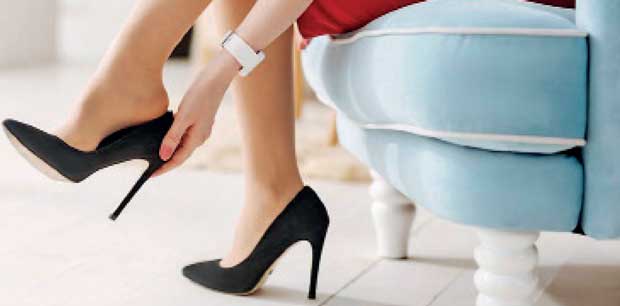Reply To:
Name - Reply Comment
Last Updated : 2024-05-04 21:04:00

 Serious health problems can occur when wearing high heels because they force an individual’s ankles to bend forward. Wearing high heels is similar to a person standing on his or her tips of the toes. Wearing high heels restricts blood circulation in your lower limbs. This can lead to spider veins and it can also shorten the muscles in your calves and stiffen your Achilles tendon, leading to pain and muscle spasms.
Serious health problems can occur when wearing high heels because they force an individual’s ankles to bend forward. Wearing high heels is similar to a person standing on his or her tips of the toes. Wearing high heels restricts blood circulation in your lower limbs. This can lead to spider veins and it can also shorten the muscles in your calves and stiffen your Achilles tendon, leading to pain and muscle spasms.
But the pain doesn’t simply occur in your legs and feet. Heels can also cause back and knee problems. For your body to stay balanced on your heels, your spine needs to sway unnaturally. This adds stress to the muscles in your spine. This results in a sore lower back. High heels are one of the most common causes of foot pain among women. As for your knees, studies reveal that heels, that are 3 1/2 inches or higher, put so much stress on your knees. Such strain could increase a woman’s risk of osteoarthritis, a common chronic condition of the joints which affects approximately 27 million Americans.
Stance
When wearing high-heeled shoes, posture changes in a manner that the back is arched, the pelvis and chest are thrust forward, the buttocks sticks out and the calf muscles tighten. When standing straight without wearing heels, the body creates a 90 degree angle with the floor, which considered to be a normal stance. If the body was a rigid column, putting on a pair of heels would force the entire body to tilt forward and the angle made with the floor would decrease or, in other words, become acute. As the height of the heel increases, this angle would decrease and make the body slant more. However, the body isn’t a rigid column, so in order to wear high-heels and maintain a normal stance, a series of joint adjustments is required. The body’s adjustment to this change in angle creates the classic, curved high-heeled stance.
Upper body
These joint adjustments are a reaction to the way high-heels cause a person’s centre of gravity to shift. As heel height increases, the location of the centre of gravity is elevated. This shift in height causes a rise in potential energy. (The most stable stance for a person is one that minimizes potential energy.) So, as heel height increases, stability decreases. Humans can control their stability by changing their stance and body position. Thus, a woman wearing heels increases the sway of her back to maintain her balance. This added arch in the back then causes the thrust of the chest, pelvis, and posterior.
 Lower Body
Lower Body
A person who has long muscular legs will create a huge impact on the lower body if she wears heeled shoes. Such people develop muscularity due to the inclination of the shoe from heel to toe. This slant is the cause of the decrease in angle when in this stance, as previously discussed. As this angle decreases with the height of the heel of the shoe, the slope becomes steeper, so the heel of the foot has to raise more. The Achilles tendon is then forced to shorten, which causes the calf muscles to increasingly flex. Thus, the slant in the shoe causes some muscles of the leg to remain flexed while the added height to the leg gives an illusion of longer legs, both of which are important contributions to the classic heeled shoe stance.
Gait cycle
The alteration in stance induces a change in gait. A normal walking cycle consists of a three-part sequence. The cycle begins with the heel coming into contact with the floor, which is known as contact. The rest of the foot is gradually brought down until it stays flat on the ground, as in a normal stance. This phase is mid-stance. Then the foot progressively rolls pressure towards the ball, so the heel raises up, which is known as push off. These three steps switch back and forth between feet to produce a fairly smooth stride.
Bounce
During normal stance, body weight is spread evenly from the heel and ball of the foot. So, the centre-of-pressure (COP), which is the average location on the foot where most weight is distributed, is located in the middle of the foot. When standing on a heel, the acute angle causes the body’s weight to shift forward, so that the centre of pressure moves toward the ball of the foot. On a high heel, 90% of the weight is focused on the ball of the foot.
When walking in heels, the COP’s location at the ball causes the contact phase to be felt mostly by the ball and the push-off phase is performed almost entirely from the ball. This transforms the smooth step sequence into a more ‘jerky’ stride. When rolling the ball, there is a smooth transition between different parts of the ball touching the ground, just like shifting between steps of the normal gait cycle. However, when the ball is bounced, one spot is continuously hitting the ground and feeling most of the impact, similar to the ball of the foot in a heeled shoe. Just like the basketball, having the contact phase felt by mostly one section creates a walk with some bounce to it.
Speed
Each gait cycle in a heeled shoe is faster than cycles in flat ones because of the shift in the centre of gravity. To initiate a walking step, you lean forward until you lose your stability. You begin to fall forward, and you step with one foot to catch your fall and reestablish your stability. Because a shift in centre of gravity makes a person less stable in heels, stability is lost more quickly when walking on high-heels, so you have to ‘catch your falls’, or take steps, more often. Research at Sungkyunkwan University’s School of Mechanical Engineering revealed that the period of one gait cycle is cut in half when wearing high-heels instead of flat shoes. More gait cycles are covered in a given distance, so someone walking in heels has very quick steps that cover a short distance.
Sway
Aside from the quick, bouncy steps, the supermodel walk needs showy hip swaying, better known as a sashay. Once again, the shift in centre of gravity is the main cause of this action. Pelvis and hip movement contributes greatly to maintaining balance and standing posture by exerting continuous muscular action to ensure equilibrium. When walking on heels, the muscular action taken is turning the hips and pelvic region more, scientifically known as torque.
That’s all there is to it - the classic strut down the catwalk is basically the body trying to keep itself balanced. The hip swaying, swift bouncy strides and prominent stance are all in reaction to a shift in centres of gravity or pressure. The illusion of muscular legs, on the other hand, is a result of positioning of the heel of the foot.
 Negative effects
Negative effects
Much work has to be put into wearing heeled shoes, which makes the attraction of wearing them not so appealing to the body. The arched back brought on by the heeled shoe alters the positions and angles at which joints are allowed to move. The pelvic and abdominal organs must adapt to these positions, which puts strain on the body. The high amount of pressure focused on the ball of the foot adds stress to the ball. Even the heel experiences strain. When walking in four inch heels, the force on the heel of the foot is equivalent to the force felt when running. The way the heel creates the look of long, muscular legs actually takes away from the propulsive power of tendon and leg muscles.
If you’re experiencing any of these issues, it’s important to visit a physician as well as a physiotherapist before they get worse. To prevent these issues from occurring, try to decrease the amount of days you wear heels — or change into flats or walking shoes when you leave work.
At the end of each day, spend a few minutes stretching your quads, calves and hip flexors with your physical therapist. Fashion doesn’t have to be synonymous with pain.
Deepthi Perera Friday, 15 December 2017 06:08 PM
Can I manage back pain with high heels using daily exercises.

Add comment
Comments will be edited (grammar, spelling and slang) and authorized at the discretion of Daily Mirror online. The website also has the right not to publish selected comments.
Reply To:
Name - Reply Comment
US authorities are currently reviewing the manifest of every cargo aboard MV
On March 26, a couple arriving from Thailand was arrested with 88 live animal
According to villagers from Naula-Moragolla out of 105 families 80 can afford
Is the situation in Sri Lanka so grim that locals harbour hope that they coul